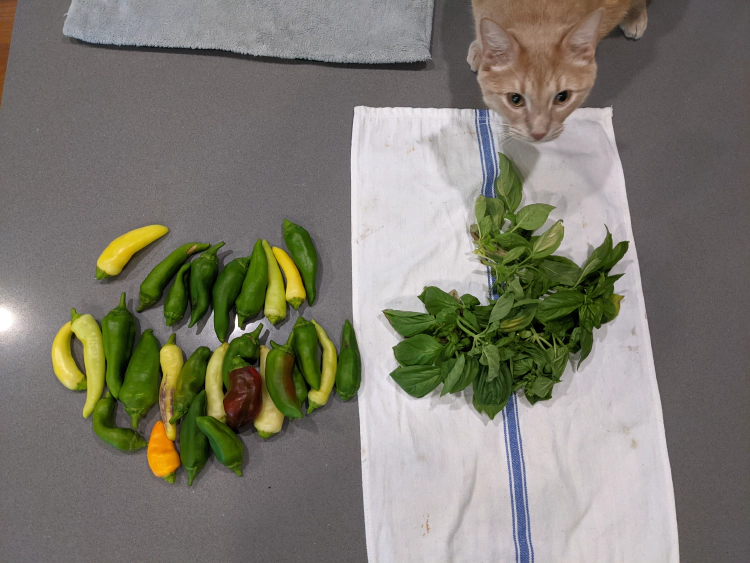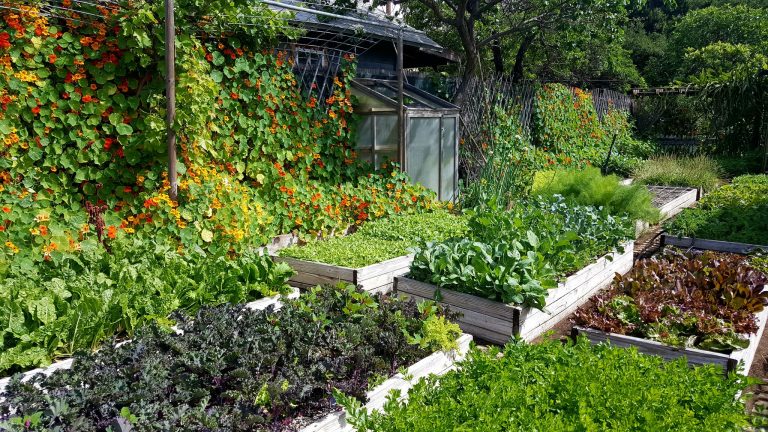Homegrown
To satisfy our son’s craving for outdoor time, my wife and I have begun journeying with the stroller to all the nooks and crannies of the vast Barton Hills neighborhood. Some of our favorite sights as of late are a 6-foot tall decorative metal rooster, a half dozen or so vividly painted Little Free Library boxes, and a well-hidden natural spring. Oh, the joys of exploring! The focus of this post, however, is a more mundane but nevertheless remarkable feature – an urban produce garden!
Based on neighborhood demographics, I suspect there are several backyard produce gardens strewn throughout the area. The garden I mention, however, is prominently located in the front yard of a large but sort of awkwardly shaped corner lot. As is typical in Austin, much of the lot is shaded by mature oak trees. The garden though is located in a clearing carved out for utility infrastructure, and it features all sorts of sun-loving herbs and vegetables.
It is a truly admirable garden, and last week I had the opportunity to say as much to its tender. I normally take my boy out for a walk shortly after he wakes, and we seldom see many people out in their yards. Because he was sick last week, his sleep schedule was all out of whack, and we didn’t head out one day until almost 10 o’clock. As we approached the garden that day, I saw a man working in it, and I decided to engage him in conversation. I said, “Hi! We frequently pass by your garden, and I just wanted to let you know how much we admire it.” He straightened up to accept the praise, smiled, and immediately proceeded to ask me if I enjoy peppers.
Before I could blurt out my affirmative answer, he had already gotten to work harvesting peppers and placing them into a reusable grocery bag for me. After placing 30 or so peppers in the bag, he added some fresh bonus basil, handed the me the bag, and introduced himself as Cliff (not his real name). I thanked him profusely and reciprocated with my own introduction. We got to talking about how Austin used to be back in the day with community gardens, our kids' picky appetites, my plight with having no room to garden in our condo, the easiness of growing microgreens, and a variety of other topics. Cliff seemed to have a deep reverence for the earth, and I was simply delighted to have had such a pleasant but unexpected encounter with him that day. Cliff’s gesture absolutely restored some of my faith in humanity, and not just because it was such a kind thing to do but also because the whole experience perfectly reflected this idealistic, community-driven brand of sustainability that I have thought a lot about recently.
Inspired by Cliff’s garden and generosity, I focus today on the sustainability of homegrown whole foods.

Solar-Powered
You might recall the Detroit Agrihood1 from my previous post. I claimed that it was a superb implementation of a sustainable idea. Why though? Let’s discuss.
First, we’re talking about whole foods – organic, unprocessed, and solar-powered. Far less energy and water are required to grow a potato than to produce an Oreo cookie, for example. The main inputs for a potato are 10-15 gallons of water, some sunshine, and perhaps a tad more energy to make the potato edible (e.g., by boiling it). To produce an Oreo, the plant inputs must first be grown, of course. But then they must also be refined, produced, and then later packaged in a factory. The resource costs of those processes are a bit of a rhetorical rabbit hole. How much energy goes into simply standing up a factory? How much energy is consumed in operating it? Is the factory located in a region whose energy is heavily dependent on gas or coal? If so, then what is the carbon footprint of Oreo production? Then start over for packaging. How much energy does it take to make a plastic Oreo tray? Are the trays made in the same factory where Oreos are produced? If not, how are they transported there? By truck or train? How are those powered? Fossil fuels? When we are finished eating the Oreos, how much energy does it then take to transport the discarded packaging to a recycling center or, worse yet, a landfill? Like I said, it’s a rabbit hole.
Second, the produce grown in the community garden is consumed locally. This drastically reduces the energy required for transporting the raw food from its source to the table. The same types of arguments we made for Oreo production and packaging may also be applied to transportation. Consider also that a package of Oreo cookies is generally only available for purchase from a grocery vendor. How much does it cost the vendor to keep the store lit and air-conditioned? Again, the point of this rhetoric is just to establish the extent to which food, energy, and transportation systems are intertwined in modern life. Perhaps this explains the resurgence of “farm-to-fork” type business in both urban and rural communities – it’s tremendously efficient and just makes sense.
Third, even when urban gardens are scaled to the extent seen in Detroit they typically do not depend on synthetic fertilizers, herbicides, pesticides, etc. – the types of chemicals that tend to pollute waterways in industrial farm settings. However, I concede the future of industrial farming looks much more promising in this regard2. Urban farms are also not so concerned with yield as they are with quality. As such, they are not turning to practices involving genetically modified organisms (GMOs) or monocultures that diminish soil fertility (and thus make the garden unsustinable).
Lastly, it’s difficult to argue that an Oreo is more nutritious than a potato. Nobody’s out there saying “an Oreo a day keeps the doctor away.” And why is that? Whole foods have this truly miraculous property that advances in technology have helped modern society to forget. Foods that are better for the earth are also better for us. I won’t sit here and tell you that [insert your unhealthy food vice here] doesn’t taste damn good, but let’s be real – it’s not doing your body any favors, and it’s not doing the earth any favors either.
This appeal to reason finally took hold in my brain last month after 31 years of my walking the earth. It is for these reasons that I have decided to base much more of my diet more on local, organic, plastic-less whole foods just like those found in Cliff’s garden.
Hyper-Localization
For folks like Cliff who have a bit of real estate, the energy requirements of food production may be reduced even further. Which is easier (i.e., which requires less energy)? Driving your car a few blocks down the road to a community garden, harvesting a squash, then driving back home? Or walking out your back door to harvest the same from your yard? Admittedly, this takes the idea of reducing energy consumption to an extreme. I’m talking about hyper-localized consumption – not just farm-to-fork, your farm to your fork.
The environmental benefit of basing a larger portion of your diet on homegrown whole foods is substantial. Of course, the main hurdle here is convincing people to invest time, money, and effort into establishing and then maintaining a garden. Many of us live very busy lives, after all. But I think most people underestimate the ease of gardening and the quantity and quality of food that may be produced on even a very patch of land. Take, for example, the Dervaes family. After spending a few years restoring the diminished soil quality in their small Los Angeles suburban yard, they leverage permaculture to sustainably yield more than 7000 pounds of food annually from just one-tenth of an acre3. And this type of food goes a long way. Whole foods, though not as artificially scrumptious as heavily processed foods, typically provide far more nutritional value, and your body does not crave nearly as much.
Wrap-Up
Let’s give thanks today to people like Cliff, the Detroit urban gardeners, and the members of the Dervaes family who are enabling healthy, sustainable eating in their local communities. Cheers to you and what you do! Please continue to teach your “act global, think local” ideology by example.

